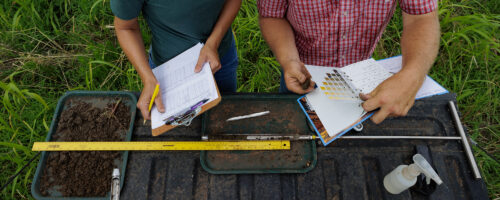Deborah Clark: Birdwell & Clark Ranch
Multiple moves per day is easier than folks think, according to this regenerative rancher.

As the last of nine semitrailers leaves the Birdwell & Clark Ranch, the low clouds overhead release a symphony of rain onto the aluminum barn roof. Deborah Clark breathes a sigh of relief and transitions from her post at the truck scales into her dry barn office.
She spends a bit more time in the office these days as the keeper of the business side of the ranch, making sure the books are kept up and the paperwork is processed. But in the early days of the ranch, she worked side-by-side with her husband, Emry Birdwell, to transition their slice of Texas into a holistic, healthy ranch.
Birdwell & Clark Ranch is a 14,200-acre spread in north-central Texas, close to the Red River. Clark describes it as a native tallgrass prairie bisected by the east fork of the Little Wichita River. Today, the ranch is home to some 3,400 head of stocker cattle that enjoy a constant buffet of forages. The cattle are moved frequently, as many as six times per day during the fast-growing season.

“It’s not prescriptive,” Clark explains of their grazing management style that responds to the forage available and the hunger of the cattle at any given time. “If you wanted to, you could move the herd into a large enough pasture so that you could take Saturday off because your kid was graduating or Sunday off because you want to go to church and then do something else. The person planning the grazing can control it. But yes,” Clark concedes to those who ask, “it does take somebody to be here and move [the cattle].”
The constant movements are also made easier on the cattle and the ranchers as a byproduct of their frequency. Clark explains the process, “We don’t force them to go to a gate. We go to where they are, lift up the wire with a PVC pipe, and the cattle just calmly walk under the raised wire to the next paddock. There’s no stress on the cattle.”
Frequently moving livestock might not be the easiest management style, but it has delivered on the goals the couple set out to achieve with their land.
“When we arrived, it was largely this plain of little bluestem. I didn’t realize it at the time, but it was a monoculture,” Clark recalls. “Now, through the type of grazing management that we’ve implemented over the last 20 years, what is coming along is just this immense amount of diversity: little bluestem, switchgrass, Indiangrass, eastern gamagrass, and the forbs and legumes, all of which are very important to us, have just flourished dramatically.”

She’s also noticed, with the help of satellite imagery, the reduction of bare ground on the ranch. She estimates that during the drought of 2011, 25% of the ranch was bare ground — no grasses covering the soil. Today, she estimates only 5% is bare.
“Ranching holistically is looking at how grazing and management can help improve your soil health,” explains Clark. “And when you improve that soil health, you improve the ability for your forages to flourish. And then when you’re doing that, you’re improving your ability to add more animals to your operation.”
The term ‘regenerative’ is used in favor of ‘holistic’ today, but the principles are nearly identical. Those principles are the foundation of Birdwell & Clark Ranch. Clark knows she wouldn’t be the rancher she is today without access to various workshops, seminars and educational courses. She also believes it’s best for ranchers to start slow and learn as much as they can as they go. Regenerative ranching isn’t about the destination, it’s a journey. Clark knows that better than most.
“We continue to change. I didn’t think we would make this last [change],” she quips, “but we’ve actually added sheep to our enterprises here. Even in our early 70s, we continue to change.”
Editor’s Note: The I’m a Regenerative Rancher series is a partnership between Noble Research Institute and Drovers to present stories that showcase the resilience, adaptability and innovation of family-owned agricultural businesses in the face of challenges and changing market conditions. For additional regenerative resources and to view all articles in the series visit Drovers.com and Noble.org.

Comment
Leave a Reply
1 comment on: "Deborah Clark: Birdwell & Clark Ranch""



Bob Alexander
July 27, 2024Smoothly written. I’ve seen the Roots So Deep video and the 2 match perfectly. Their focus on the details of rangeland conditions and their direct observation of the various grasses is underplayed here – it’s the basis for the grazing opns’ success. It’s not by chance; they use the data to plan the moves.